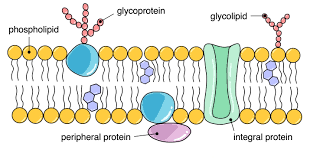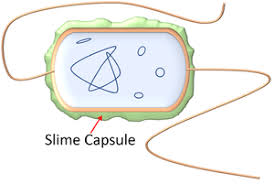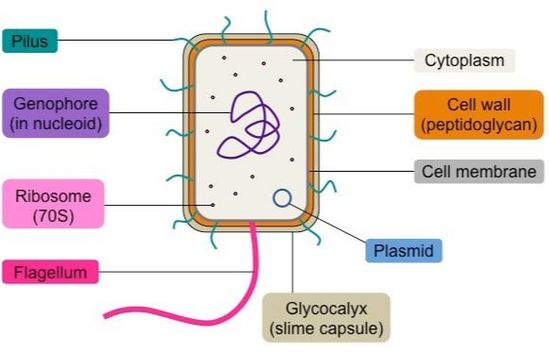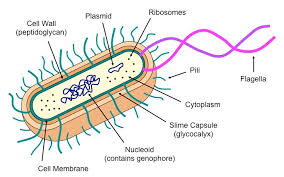Cell Biology
1/52
There's no tags or description
Looks like no tags are added yet.
Name | Mastery | Learn | Test | Matching | Spaced |
|---|
No study sessions yet.
53 Terms
Strcutres common to cells in all living organisms
cell wall, plasma membrane, cytoplasm, ribosome, nucleoid, flagella, pilli, Slime capsule, plasmids,
Hyphae (fungi)
are the tubular projections of multicellular fungi that form an underground filamentous network (mycelium).
Fungal hyphae are sometimes not divided up into individual cells (called aseptate hyphae), resulting in a continuous cytoplasm along the length of the hyphae.
Discrepancy: Aseptate hyphae are not made of clearly defined individual cells, rather continuous structures with multiple nuclei.
Surface area-to-volume ratios and constraints on cell size:
My (Molecule 1nm) Money (Membrane 10nm) Vanishes (Virus 100nm) Beautifully (Bacteria 1 ,um) On (Organelle 10 ,um) Cars (Cells 100 ,um).
nm = a billionth of a meter. ,um = a millionth of a meter
Integral proteins
Integral proteins are usually enzymes or pumps. Enzymes=sites for chemical reactions. Pumps= for active transport of molecules.
Channel proteins for facilitated diffusion:
Facilitated diffusion involves the use of a protein to facilitate the movement of molecules across the membrane. In some cases, molecules pass through channels within the protein.
Functions of plasma membrane proteins:
selective transport channel, enzyme active site, cell surface receptor, cell surface identity marker, cell adhesion, attachement to cytoskeleton
State the name of one type of membrane protein that is required for facilitated diffusion to take place.
channel/carrier protein
Facilitated diffusion requires carrier proteins and channel proteins that are specific to the molecule that is being transported across the membrane.
Cytoplasm:
Contains all the enzymes needed for all metabolic reactions, since there are no organelles.
Pilli:
These thread like projections are usually more numerous than the flagella. They are associated with different types of attachment. In some cases they are involved in the transfer of DNA in a process called conjugation or alternatively as a means of preventing phagocytosis.
Atypical cell structure in eukaryotes:
Red blood cells, Hyphae, Skeletal Muscle, Sieve tube
Skeletal muscle fiber cells (animal/human)
result from the fusion of multiple unicellular cells. This results in a single large cell that has multiple nuclei (B2.3.9).
Discrepancy: a very large eukaryotic cell with more than one nucleus!
Fluid mosaic model of membrane structure:
It has glycoprotein , integral protein, cholestrol , peripheral proteins, channel protein

Peripheral protein
Peripheral protein act as receptors and 'recognise' other cells.
Movement of water molecules across membranes by osmosis:
Osmosis is the passage of water from a region of high water concentration (dilute solution) through a semi-permeable membrane to a region of low water concentration.
Which molecule moves by simple diffusion?
Oxygen
Explanation:
Oxygen is a small, hydrophobic molecule that can move through the plasma membrane by simple diffusion.
Phospholipids are -- which means they have both hydrophobic and hydrophilic regions. This property allows them to form ---- in water.
1. amphipathic
2. bilayers
Membrane proteins of hamster cells were marked with a blue dye and membrane proteins of human cells were marked with a green dye. What would be seen after the fusion of the cells?
Blue and green marker dyes fully mixed.
Explanation:
The fluid mosaic membrane models predicts that the membrane behaves like a fluid. In a fluid the colours would be mixed as cells fuse.
Some membrane-spanning proteins are able to change shape to allow materials to cross the cell membrane. Name the type of integral membrane protein that has this function.
protein pump
Protein pumps change shape in order to transport the molecules across the membrane. An example is the sodium-potassium pump. Whilst channel proteins are integral and membrane spanning, they allow passive diffusion and do not change their shape.
State the type of integral, membrane-spanning protein that allows the facilitated transport of materials in and out of the cell.
channel/carrier protein
The channel protein allows substances and materials to move in and out of the cell without any need for an energy input. "Protein channel" is not correct because it implies a channel that only transports proteins.
Identify something that does not impact both simple and facilitated diffusion.
The presence of phospholipids in the membrane.
Explanation:
Membranes are always composed of phospholipids, yet they efficiently perform their functions and diffusion tasks without a problem. Therefore, the presence of phospholipids in the membrane should be the answer of choice. To the contrary, particle size, concentration gradient of the diffusing particles and the surface area of the membrane all have an impact on simple and facilitated diffusion.
What is a requirement for osmosis to occur?
A partially permeable membrane
Osmosis requires a partially permeable membrane with aquaporins. Osmosis does not require an active protein or a protein pump. Osmosis does not require a form of energy.
Needs for life
Breathing/respiration
Excretion
Reproduction
Locomotive (movement)
Irritability (Senses)
Nutrition
Death
Osmo regulation
Growth
Cells - the presence of
light vs. electron microscope
Light: Uses glass lenses to bend light to magnify images. Advantages include cheaper, mobile, low tech.
Electron: Electromagnets to focus electrons + produce monochromatic images.
Magnification=light has much less, electron has much greater.
Resolution= light has lower and electron is higher.
Image formed by= light uses light and electro uses electrons.
Organisms= light can do alive or dead, electron can only do dead.
Image: Light -> they may be in color. Electron -> false color or monochromatic.
Cell Wall:
Made of a murein (not cellulose). Provides structure to the cell, prevents explosion by osmotic pressure.
Plasma membrane:
Controls the entry and exit of substances, pumping some of them in by active transport.
- selectively permeable
Ribosome:
The smaller (70 S) type are all free in the cytoplasm, not attached to membranes (like RER). They are used in protein synthesis which is part of gene expression.
Flagella:
These long thread like attachments are generally considered to be for movement. They have an internal protein structure that allows the flagella to be actively moved as a form of propulsion.
Slime Capsule:
A thick polysaccharide layer outside of the cell wall. Used for sticking cells together, as a food reserve, as protection against drying out and chemicals, and as protection against phagocytosis. In some species the capsules of many cells in a colony fuse together forming a mass of sticky cells called a biofilm. Dental plaque is an example of a biofilm.

Plasmids:
Extra-nucleoid DNA of up to 400 kilobase pairs. Plasmids can self-replicate particularly before binary fission. They are associated with conjunction which is horizontal gene transfer.
- small circular DNA molecules
It is normal to find at least one anti-biotic resistance gene within a plasmid. This should not be confused with medical phenomena but rather is an ecological response to other antibacterial compounds produced by other microbes.
Commonly fungi will produce anti-bacterial compounds which will prevent the bacteria replicating and competing with the bacteria for a resource.

Nucleoid:
Is the region of the cytoplasm that contains DNA. It is not surrounded by a nuclear membrane. DNA is sometimes in a closed loop (i.e. a circular PLASMID), and not associated with any proteins to form chromatin.
Prokaryote cell structure:
The general size of a prokaryotic cell is about 1-2 um.
•Note the absence of membrane bound organelles
•There is no true nucleus with a nuclear membrane
•The ribosome's are smaller than eukaryotic cells
•The slime capsule is used as a means of attachment to a surface
•Only flagellate bacteria have the flagellum
•Plasmids are very small circular pieces of DNA that maybe transferred from one bacteria to another.

Eukaryote cell structure:
Cells similar to prokaryote cells however they have a nucleus and a nuclear membrane.
Processes of life in unicellular organisms:
Unicellular organisms are single-celled organisms.
They only consist of one cell.
Despite so, they are capable of performing all living processes such as respiration, growth, movement, reproduction, feeding and excretion. Some examples include bacteria, protozoa, algae, fungi, etc.
Differences in eukaryotic cell structure between animals, fungi and plants:
Animal cells are typical of the eukaryotic cell, enclosed by a plasma membrane and containing a membrane-bound nucleus and organelles.
Unlike the cells of the two other eukaryotic kingdoms, plants and fungi, animal cells don't have a cell wall.
Red blood cells (human/animal)
, also called erythrocytes, are the most common blood cells and function in oxygen transport in vertebrates.
Sieve tube elements
are specialized cells that are part of the phloem, the tissue that transports organic compounds made during photosynthesis throughout a plant (B3.2.18).
Sieve tube elements lose their nucleus and other organelles during their development. This allows the cells to have more space for transport of phloem sap.
Discrepancy: a eukaryotic cell without organelles!
Surface area and volume:
The surface area relates to how much material can enter a cell at a time.
The bigger the area is the more material can enter in an amount of time.
The volume relates to how much material is needed at a time.
The bigger the volume is the more material is needed to maintain it for an amount of time.
Surface area + volume in terms of heat and waste.
Elephant.
Large organisms it produces a lot of heat (relatively small surface area in comparison to volume).
Elephants use their ears to cool their body down and control their temp.
The size of their ears are proportionate to the amount of heat they dispell.
Shrew.
Small organisms dont produce a lot of heat (relatively large surface area in comparison to volume).
They have a fast and constant metabolic rate so that they can stay warm since that process creates heat.
Cell size as an aspect of specialization.
Humans have 220 distinct specialised cells. Specialisation affects form since form and function are related. Specialisation happens due to differenciation.
Differenciation:
the switching on (expression) of some genes and switching off (no-expression) of others.
Levels or organisation.
Cells -> tissue -> organs->systems->organism
Lipid bilayers as the basis of cell membranes:
Lipid biyalers are the lining of the cell membrane that are semi-permeable. They are amphipatic with a hydrophillic head and a hydrophobic body which create a protective layer around the cell membrane.
Small uncharged moleucles can pass through the layer while larger molecules have more trouble.
glycoprotein
glycogen and protein -> combine with carbohydrates to make chemical receptors
cholestrol in fluid mosaic
(affects membrane fluidity at different temperatures -> helps bilayer stay fluid)
channel protein
carry molecules through the plasma membrane
Lipid bilayers as barriers:
The amphipathic nature of the phospholipid bilayer allows for important properties of the cell membrane.
For example, the hydrophobic nature of the tails promotes the selective permeability of the membrane.
Large molecules or hydrophilic molecules are unable to pass through the bilayer without assistance.
Simple diffusion across membranes:
A type of passive transport (requires no extra energy). Its the movement of molecules from an area of high concentration to an area of low concentration.
- concentration gradient
Facilitated Diffusion:
The use of protein to facilitate the movement of molecules across the membrane.
In some cases the molecules go through channels within the protein.
This is a form of active transport (type of transport where substances move against a concentration gradient, in the opposite direction to diffusion.
It needs energy and a protein pump, which is found in a membrane, to work)
Cell wall and Osmosis
The prescence of a cell wall impacts the affects of Osmosis.
No cell wall (animal cells)=the cell membrane expands continously (volume increases) till it bursts since the pressure outwards is greater than pressure inwards -> lysed.
With cell wall (plant and fungi cells) = the cell wall limits how much the cell membrane expands since it limits the volume of the cell membrane (pressure outwards<pressure inwards).
Ex. of Osmosis:
Plants - water taken in from the soil. The roots take water from areas of high concentration (hypertonic : the soil) to areas of low concentration (hypotonic: the roots) and transport them up to different parts of the plant using xylem vessels.
Pump proteins for active transport:
Active Transport is a type of transport where substances move against a concentration gradient, in the opposite direction to diffusion. (From an area of lower concentration to an area of higher concentration.) Active transport needs energy and a protein pump (found in a membrane) to work. Facilitated diffusion is a type of active transport
Plasmolysed:
When the cell shrinks so much that there's a distance between the cell membrane and cell wall (not applicable for animal cells because they have no cell walls)
Name an example of Transport, Hormone, Enzyme, and structure protein
Transport- Haemoglobin : oxygen in blood
Hormone- Testosterone: male reproductive hormone
Enzyme- Catylase: present in nearly all living organisms and helps break down hydrogen peroxide into hydrogen and oxygen
Structure- Keratin: Helps in building hair and nails